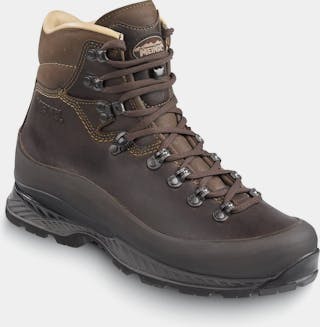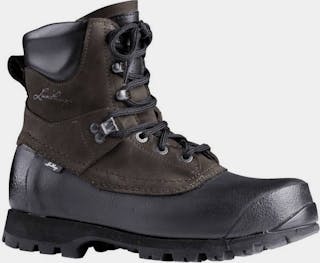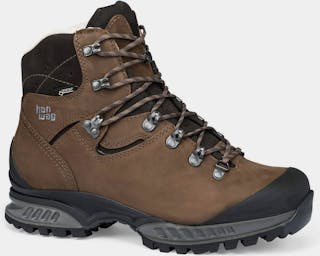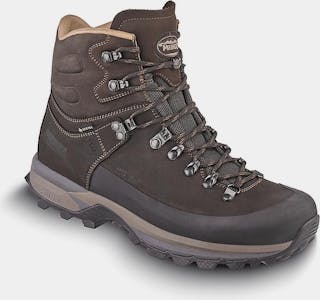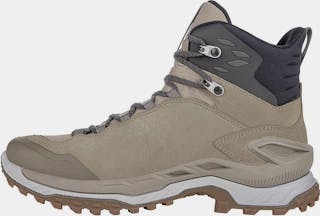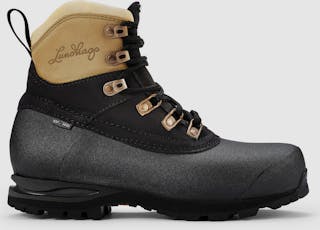Hiking Boots Support and Protect Your Feet
Hiking boots are one of the most important pieces of gear for a successful trek. Their main function is to provide the right support for your ankles and soles, depending on the intended use. We offer a range of boots from day hiking models to those suited for conquering high mountain terrain. The lighter the load you carry, the more flexible your boots can be. For backpacking in demanding terrain, stiff and supportive boots are ideal. On hard surfaces, like in a store, these boots may feel overly rigid at first, but once you’re out in the terrain with a loaded pack, they prove to be just right. Many dog owners also prefer to use sturdy hiking boots for all their walks.
Waterproof or Not?
The majority of hiking boots sold in Finland are equipped with waterproof membranes. The popularity of Gore-Tex footwear stems largely from our wet terrain, where rubber boots were once the standard for hikers. Hiking boots keep your feet dry and also provide the support you need when walking, possibly already a bit tired, with a heavy load over rocky ground. For some hikers, non-membrane boots are the right choice, and we offer those as well.
How Supportive Should Your Boots Be?
Hiking boots often have a stiffness rating – this indicates how supportive and rigid the boots are. A and A/B class boots are suitable for day hikes and light trekking, while B, B/C, and C class boots are made for tougher terrain and heavy backpacks. Some brands use their own rating systems, but we aim to describe the intended use for every model. Stiffness refers to ankle support as well as torsional and bending rigidity of the sole. Even stiff boots can be made more comfortable thanks to smart lacing systems that allow you to tighten around the instep and loosen the shaft – ideal for steep trails.
Proper Care Extends Boot Lifespan
Take care of your hiking boots to keep them in good shape. Especially if you often hike through swamps, rinse your boots with clean water after each use to prevent acidic swamp water from causing damage. Brush or wipe off loose mud and dust. Leather and textile materials on hiking boots are treated with a water-repellent coating. This not only protects against water but also keeps the material breathable: when saturated, moisture can no longer escape. The coating gradually wears off. You’ll notice this when stepping into a puddle – on freshly treated boots, water beads on the surface, while worn-out coatings allow water to soak in. Leather boots should also be waxed once or twice a year. Wax conditions the leather and prevents it from drying out. Meindl and Nikwax produce excellent boot care products to maintain your footwear. Always ensure that your care product is suitable for your boots: products suitable for Gore-Tex will mention it specifically. Our selection includes reliable and easy-to-use care products. Care for your boots – your feet will thank you!
If there’s a long break in boot use, the sole may develop a hardened surface. You can safely tackle this with a steel brush – just rough up the tread pattern slightly. Hiking boots benefit from use: even light regular wear keeps the midsoles functional. Store your boots in a cool, dark place – never on underfloor heating.
Hiking Boots and Socks – A Perfect Match
Hiking boots work best with proper hiking socks. We recommend using thin liner socks under midweight hiking socks. This way, the socks rub against each other, significantly reducing skin friction. On long treks, changing the liner sock helps a lot, while the outer hiking sock can usually handle several days without getting too dirty. The material of the socks affects warmth – choose high wool content for winter, and synthetics for summer conditions.
Even though brands like Meindl often feel great right out of the box, we always recommend walking a few short hikes in your new boots before heading out on a long trip. This helps them mold to your feet and ensures they won’t cause blisters.
Order now from a Finnish specialty store – delivery available right to your doorstep if needed, with a wide product range including wide fit shoes!!













